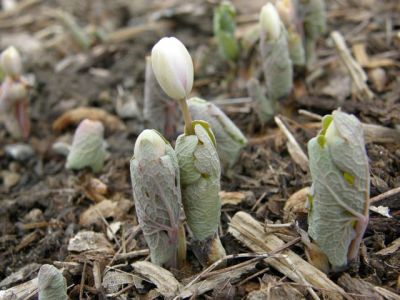 …is the fitting name given to spring’s woodland wildflowers.
…is the fitting name given to spring’s woodland wildflowers.
Their blooming period is very short, timed to fall between the last frost and forest leaf-out. In southwestern Pennsylvania that’s late April to early May – about three weeks. The flowers of some species may be present for only a few days so if you don’t visit the forest every day you’ll miss them.
I remember the first time I learned about spring ephemerals through a class in the 1990s at the Rachel Carson Institute at Chatham College (now University). Until that point, spring for me was about about daffodils, tulips and lilacs. Suddenly a whole new world opened up, the world of the original flowers from which the rest were bred, the truly wild flowers that grow on their own without our intervention.
Some wild flowers, like the Bloodroot pictured here, take the chance of emerging when frost is still a real possibility. A member of the poppy family and one of the earliest to bloom, it’s named bloodroot for the red sap in its root. The sap tinges the veins of emerging leaves a faint pick color, as you can see.
This is how I normally find bloodroot with leaves folded like hands around the flower stem and the flower closed. My timing is off. It is too cold or too early in the season to see the bloom. You can see it though, if you click on the picture.
I found a single bloodroot flower blooming at Raccoon Creek Wildflower Reserve on April 5 but none on Easter a week later. I came at the wrong time; it was very cold.
They are truly ephemeral.
(photos by Marcy Cunkelman)
I have been watching for bloodroot across the river – haven’t spotted any yet – still looking 🙂
I think I just transplanted some of these flowers from a junk strewn hill side near McKeesport Pa to my yard in Oakmont. No one so far has described the root, which in my flowers is a twisted tuberous mass from which various flowers and large leaves spring. Is this what I have? Blood root? If so, I would like to know as much about it as possible. Trillium, Virginia bluebells, and trout lily (all acquired from nurseries) exist in my little pseudo woodland, but only the trout lily is thriving. What do I need to do to make these beauties happy in their new home?
Nancy, If it is bloodroot, the tuber will “bleed” a red sap when opened. (See this info on Wikipedia)
I don’t know how to make wildflowers thrive in captivity but you may get some assistance from Audubon at Beechwood (aswp.org) where they sell native plants.